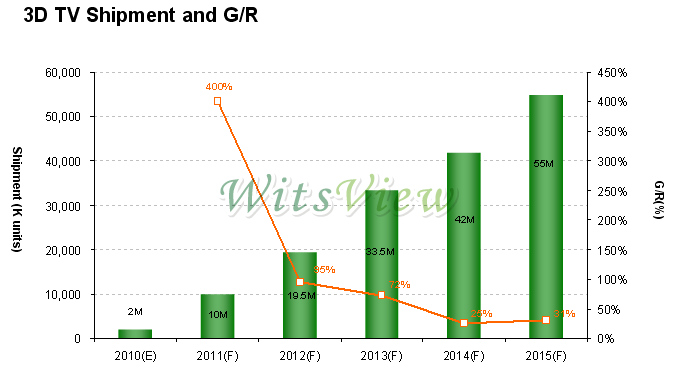3D TV shipments to witness phenomenal growth estimated at 10 million units in 2011
Wednesday, April 28th, 2010
With its astounding visual effects, 3D technology has stirred up a new trend in the display market. WitsView, TFT-LCD industry research institute, indicated that consumers’ acceptance of this technology is evident from the impressive figures from 3D movie box office sales. 2010 is the beginning of a promising era for 3D TV; and in 2011, 3D TV shipments will likely witness phenomenal growth, estimated at 10 million units. Furthermore, 3D TV market penetration is estimated to be close to 10% in 2012, and 20% in 2015.
The range of 3D applications extends from the TVs, notebooks, cell phones, to digital frames and other such electronic display products. However, one of the factors that affect the penetration of 3D TV is that development of 3D hardware is far more advanced than that of 3D software. Based on current market dynamics, WitsView estimated that 3D market demand will mainly be driven by the segments that require higher visual performance, namely gaming and digital cinema.
For in-home entertainment, due to the high price and limited content availability of 3D TV, it would take another two to three years before 3D TV becomes popular. In 3D imaging technology, the outstanding image performance of shutter glass is the most compatible with the requirements of 3D display in the high-end movie and gaming market, despite its higher costs compared to that of other 3D technologies. Therefore, WitsView projects that shutter glass technology will likely become a market mainstream.
To truly enjoy the 3D surround visual and sound effects at home, it may cost about NT$150,000 (~US$4650 at US$1:NT$32.26), estimated WitsView. This cost involves a set of Samsung’s 55-inch 3D LED TV, and other audio-visual equipment including a Blu-ray player, rechargeable 3D glasses, and a surround sound system.
In addition, lenticular technology allows viewer to experience 3D visual effects without the need to wear glasses; however, to achieve 2D/3D switchable, its cost is comparable to that of shutter glasses. WitsView noted that lenticular technology is more suitable for applications in small portable devices.

Source:WitsView

Source:WitsView
Latest News
- Barb to start reporting TV-set viewing of YouTube channels
- SAT FILM selects multi-DRM from CryptoGuard
- Qvest and ARABSAT to launch OTT streaming platform
- ArabyAds & LG Ad Solutions partner with TVekstra in Turkey
- Freeview NZ satellite TV service to move to Koreasat 6
- Comscore expands YouTube CTV measurement internationally
